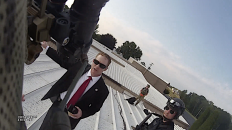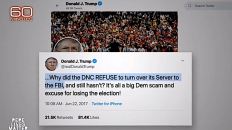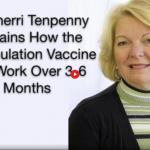A whistleblower has come forward with an explosive new trove of documents, rivaling or exceeding the Twitter Files and Facebook Files in scale and importance. They describe the activities of an “anti-disinformation” group called the Cyber Threat Intelligence League, or CTIL, that officially began as the volunteer project of data scientists and defense and intelligence veterans but whose tactics over time appear to have been absorbed into multiple official projects, including those of the Department of Homeland Security (DHS).
The CTI League documents offer the missing link answers to key questions not addressed in the Twitter Files and Facebook Files. Combined, they offer a comprehensive picture of the birth of the “anti-disinformation” sector, or what we have called the Censorship Industrial Complex.
The whistleblower’s documents describe everything from the genesis of modern digital censorship programs to the role of the military and intelligence agencies, partnerships with civil society organizations and commercial media, and the use of sock puppet accounts and other offensive techniques.
“Lock your shit down,” explains one document about creating “your spy disguise.”
Another explains that while such activities overseas are “typically” done by “the CIA and NSA and the Department of Defense,” censorship efforts “against Americans” have to be done using private partners because the government doesn’t have the “legal authority.”
The whistleblower alleges that a leader of CTI League, a “former” British intelligence analyst, was “in the room” at the Obama White House in 2017 when she received the instructions to create a counter-disinformation project to stop a “repeat of 2016.”
Over the last year, Public, Racket, congressional investigators, and others have documented the rise of the Censorship Industrial Complex, a network of over 100 government agencies and nongovernmental organizations that work together to urge censorship by social media platforms and spread propaganda about disfavored individuals, topics, and whole narratives.
The US Department of Homeland Security’s Cybersecurity and Information Security Agency (CISA) has been the center of gravity for much of the censorship, with the National Science Foundation financing the development of censorship and disinformation tools and other federal government agencies playing a supportive role.
Emails from CISA’s NGO and social media partners show that CISA created the Election Integrity Partnership (EIP) in 2020, which involved the Stanford Internet Observatory (SIO) and other US government contractors. EIP and its successor, the Virality Project (VP), urged Twitter, Facebook and other platforms to censor social media posts by ordinary citizens and elected officials alike.
Despite the overwhelming evidence of government-sponsored censorship, it had yet to be determined where the idea for such mass censorship came from. In 2018, an SIO official and former CIA fellow, Renee DiResta, generated national headlines before and after testifying to the US Senate about Russian government interference in the 2016 election.
But what happened between 2018 and Spring 2020? The year 2019 has been a black hole in the research of the Censorship Industrial Complex to date. When one of us, Michael, testified to the U.S. House of Representatives about the Censorship Industrial Complex in March of this year, the entire year was missing from his timeline.
An Earlier Start Date for the Censorship Industrial Complex
Now, a large trove of new documents, including strategy documents, training videos, presentations, and internal messages, reveal that, in 2019, US and UK military and intelligence contractors led by a former UK defense researcher, Sara-Jayne “SJ” Terp, developed the sweeping censorship framework. These contractors co-led CTIL, which partnered with CISA in the spring of 2020.
In truth, the building of the Censorship Industrial Complex began even earlier — in 2018.
Internal CTIL Slack messages show Terp, her colleagues, and officials from DHS and Facebook all working closely together in the censorship process.
The CTIL framework and the public-private model are the seeds of what both the US and UK would put into place in 2020 and 2021, including masking censorship within cybersecurity institutions and counter-disinformation agendas; a heavy focus on stopping disfavored narratives, not just wrong facts; and pressuring social media platforms to take down information or take other actions to prevent content from going viral.
In the spring of 2020, CTIL began tracking and reporting disfavored content on social media, such as anti-lockdown narratives like “all jobs are essential,” “we won’t stay home,” and “open America now.” CTIL created a law enforcement channel for reporting content as part of these efforts. The organization also did research on individuals posting anti-lockdown hashtags like #freeCA and kept a spreadsheet with details from their Twitter bios. The group also discussed requesting “takedowns” and reporting website domains to registrars.
CTIL’s approach to “disinformation” went far beyond censorship. The documents show that the group engaged in offensive operations to influence public opinion, discussing ways to promote “counter-messaging,” co-opt hashtags, dilute disfavored messaging, create sock puppet accounts, and infiltrate private invite-only groups.
In one suggested list of survey questions, CTIL proposed asking members or potential members, “Have you worked with influence operations (e.g. disinformation, hate speech, other digital harms etc) previously?” The survey then asked whether these influence operations included “active measures” and “psyops.”
These documents came to us via a highly credible whistleblower. We were able to independently verify their legitimacy through extensive cross-checking of information to publicly available sources. The whistleblower said they were recruited to participate in CTIL through monthly cybersecurity meetings hosted by DHS.
The FBI declined to comment. CISA did not respond to our request for comment. And Terp and the other key CTIL leaders also did not respond to our requests for comment.
But one person involved, Bonnie Smalley, replied over Linked in, saying, “all i can comment on is that i joined cti league which is unaffiliated with any govt orgs because i wanted to combat the inject bleach nonsense online during covid…. i can assure you that we had nothing to do with the govt though.”
Yet the documents suggest that government employees were engaged members of CTIL. One individual who worked for DHS, Justin Frappier, was extremely active in CTIL, participating in regular meetings and leading trainings.
CTIL’s ultimate goal, said the whistleblower, “was to become part of the federal government. In our weekly meetings, they made it clear that they were building these organizations within the federal government, and if you built the first iteration, we could secure a job for you.”
Terp’s plan, which she shared in presentations to information security and cybersecurity groups in 2019, was to create “Misinfosec communities” that would include government.
Both public records and the whistleblower’s documents suggest that she achieved this. In April 2020, Chris Krebs, then-Director of CISA, announced on Twitter and in multiple articles, that CISA was partnering with CTIL. “It’s really an information exchange,” said Krebs.
The documents also show that Terp and her colleagues, through a group called MisinfoSec Working Group, which included DiResta, created a censorship, influence, and anti-disinformation strategy called Adversarial Misinformation and Influence Tactics and Techniques (AMITT). They wrote AMITT by adapting a cybersecurity framework developed by MITRE, a major defense and intelligence contractor that has an annual budget of $1 to $2 billion in government funding.
Terp later used AMITT to develop the DISARM framework, which the World Health Organization then employed in “countering anti-vaccination campaigns across Europe.”
A key component of Terp’s work through CTIL, MisinfoSec, and AMITT was to insert the concept of “cognitive security” into the fields of cybersecurity and information security.
The sum total of the documents is a clear picture of a highly coordinated and sophisticated effort by the US and UK governments to build a domestic censorship effort and influence operations similar to the ones they have used in foreign countries. At one point, Terp openly referenced her work “in the background” on social media issues related to the Arab Spring. Another time, the whistleblower said, she expressed her own apparent surprise that she would ever use such tactics, developed for foreign nationals, against American citizens.
According to the whistleblower, roughly 12-20 active people involved in CTILworked at the FBI or CISA. “For a while, they had their agency seals — FBI, CISA, whatever — next to your name,” on the Slack messaging service, said the whistleblower. Terp “had a CISA badge that went away at some point,” the whistleblower said.
The ambitions of the 2020 pioneers of the Censorship Industrial Complex went far beyond simply urging Twitter to slap a warning label on Tweets, or to put individuals on blacklists.
The AMITT framework calls for discrediting individuals as a necessary prerequisite of demanding censorship against them. It calls for training influencers to spread messages. And it calls for trying to get banks to cut off financial services to individuals who organize rallies or events. The timeline of CISA’s work with CTIL leading up to its work with EIP and VP strongly suggests that the model for public-private censorship operations may have originated from a framework originally created by military contractors. What’s more, the techniques and materials outlined by CTIL closely resemble materials later created by CISA’s Countering Foreign Intelligence Task Force and Mis-, Dis-, and Maliformation team.
Over the next several days and weeks, we intend to present these documents to Congressional investigators, and will make public all of the documents we can while also protecting the identity of the whistleblower and other individuals who are not senior leaders or public figures. But for now, we need to take a closer look at what happened in 2018 and 2019, leading up to the creation of CTIL, as well as this group’s key role in the formation and growth of the Censorship Industrial Complex.























TONZ of buggy looking ads,, and a 10 Min UTUBE VID, some kids opinion!! ADMIN:;:!!!!!! CHECK YOUR WORK!!
What’s YOUR problem, exactly?
The article was written by Michael Shellenberger, who testified today before the House Subcommittee on the Weaponization of the Federal Government and it includes the graphics that were published in that article. The video is by Matt Taibbi, another person who also testified today before the Weaponization Subcommittee.
All you have to do is look at what they name stuff, and then know they are exactly opposite of what it says.
The odds are =you re right
It is worth mentioning that such evil behaviors against the free citizens of the USA were allowed to take place under Trump. So either Trump is evil and supported such activities, or Trump is stupid and incapable of running his government.
Left-hand, right-hand we’re always being played -and divided! Perhaps they let him run, to take out the other GOP candidates. Maybe they thought he’d drive the People to HRC, but they misread the public.
They certainly seem to persecute the man, but is it showmanship? Is it all scripted; while they play US into an Orwellian/Idiocracy?
There’s very little of the various towers of power that are trustworthy at present.